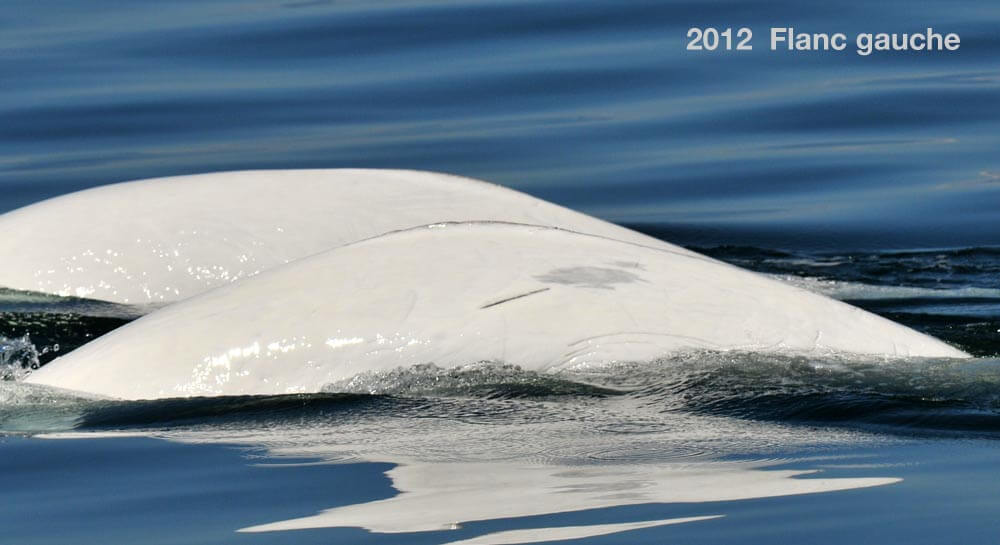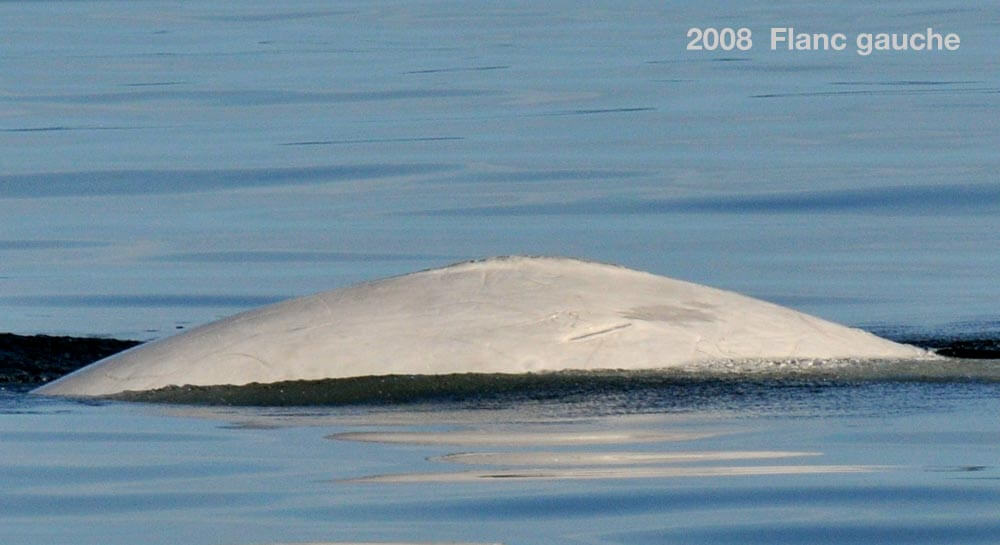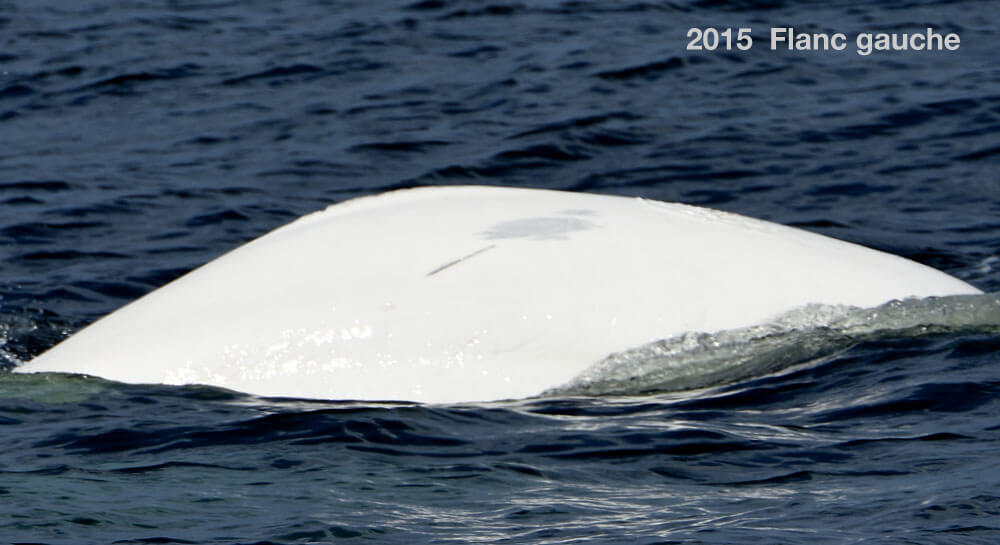Leucas
Beluga


Adopted by Justin Trudeau, Prime Minister of Canada
-
ID number
DL2542
-
Sex
Male
-
Year of birth
Circa 2000
-
Known Since
2007
Distinctive traits
Leucas is difficult to identify from the right flank. On the other hand, he has a spot, like a brushstroke, on his left flank. Just below this spot, he bears a deep scar.
Life history
We first met Leucas in the summer of 2007. At the time, he was a very young gray beluga. Seen almost every year thereafter, in 2015 he is slightly gray, almost white. Beluga whales change color from gray to white between the ages of 12 and 16. Leucas was born around 2000.
Leucas’ courtship suggests that he is male. In fact, there is a form of sexual segregation among belugas. Particularly in summer, males and females live separately and frequent different areas. Three networks of males are known : two criss-cross the Saguenay Fjord and the head of the Laurentian Channel, while another, the “Downstream boys”, use the head of the Laurentian Channel and the downstream portion of the Estuary. Although their territories overlap, individuals from one network have very little contact with males from other networks.
For the moment, we can’t define Leucas’ network of males and loyal mates. As adults, males tend to form stable bands of mates. These associations, which gradually become established during adulthood, may be important for the beluga’s reproductive life.
The rest of Leucas’s story will tell us a lot about the evolution of the beluga’s social life. For example, which area will he prefer as he grows older? Who will be his life companions? By understanding how belugas live, we can better protect them.
Observations history in the Estuary
Years in which the animal was not observed Years in which the animal was observed
Latest news
It’s the perfect afternoon for photo-identification: no wind, few waves and excellent visibility. We’re in the Cacouna sector, where we are observing a herd of 20 to 30 belugas. The animals are moving in disorganized fashion in every which direction. Groups are continually forming and disbanding. To properly identify the belugas, we must photograph both their left and right flanks. However, they are very active and difficult to approach. As they are moving without rhyme or reason, guessing where they will surface next is a challenge, further complicating our task of positioning the boat. Nevertheless, we still manage to photograph and identify Leucas, DL9051 and DL9109. One beluga catches us by surprise by slapping its tail. We would love to know what’s getting these belugas so worked up!
In September, we embark on an intensive biopsy campaign. Under sunny skies, we cross the St. Lawrence to the ile aux Basques area, opposite Trois-Pistoles. We found a herd of around 75 belugas, virtually all males. How do we know they’re males? Because they’re downstream – an area mostly frequented by males – it’s a large group, the individuals are of good size and there are no very young ones among them. The herd is widely scattered, but there are three large groups of 8 to 14 plump individuals. In one of them, we recognize Leucas, swimming in the company of two adults and a young gray. We want to take a biopsy from him, but only succeed in catching his swimming companion. In the end, we managed to take four biopsies.
We see Leucas at the mouth of the Saguenay Fjord, between Pointe Noire and Pointe Rouge. He is in a herd of around fifty individuals, including adults and a few juveniles. Leucas swims with Dimitri in a group of 20 very active individuals. The mouth of the Saguenay is a meeting place! Networks of male belugas meet herds of females with young. The abundance of food can lead to ephemeral gatherings.
Sponsor
Delphi and Leucas were entrusted to the Right Honourable Justin Trudeau and the Honourable Philippe Couillard, respectively Prime Minister of Canada and Premier of Quebec, by Robert Michaud, GREMM’s Scientific Director, concerned about the survival of the belugas.
Prime Ministers, thank you for taking care of Delphi and Leucas
Mr Trudeau, Mr Couillard, allow me to introduce Delphi and Leucas. These are two belugas that I see every summer in the St. Lawrence. Both are less than 20 years old. Delphi is a female and should give birth to her first calf soon. Leucas is a male and spends his time weaving his social network. They belong to an “endangered” population and need your immediate help. If we share the St. Lawrence with them, they could live until 2080!
Our choices today shape the world in which they will live. It’s those choices I’d like to talk to you about. But first, let me tell you a little more about Delphi and Leucas.
Thanks to their distinctive markings, I’ve learned to recognize hundreds of belugas one by one. Over the years, I’ve gotten to know them. Over the years, they’ve told me their story, the story of the St. Lawrence, and a little of our story too.
Like us, belugas have colonized the St. Lawrence. Driven from the Arctic by the last ice age, they found refuge here 10,000 years ago. In 1535, Cartier wrote that many white porpoises lived in this great river called the St. Lawrence. Since then, their numbers have steadily declined, and the Fleuve aux Grandes Eaux has changed. These changes are accelerating, and with them, our concerns!
Never before have we been so aware of these changes. Never before have we had so much science to identify, understand, mitigate and perhaps reverse these changes.
When, in the 1930s, fishermen complained that belugas were decimating salmon and cod, we bombarded them. Until 1939, bounties were paid to hunters. This race to exterminate came to an end following a scientific study which concluded that cod and salmon were rarely eaten by belugas.
A few hundred belugas survived this exploitation to find themselves in the most toxic period of the St. Lawrence, at the heart of the industrial era. As a result of decades of efforts to improve the health of the St. Lawrence, contaminants banned in the early 1970s are now on the decline in belugas, and the cancers that killed a quarter of adult belugas have disappeared.
However, belugas have not been saved from the waters. Their population is once again in decline, and mortality among pregnant females and newborn calves is on the rise. According to the Species at Risk Act, an “endangered” population faces imminent extirpation or extinction if nothing is done to counteract the factors threatening its disappearance. And now, we can no longer plead ignorance.
Some of the threats facing belugas are difficult to reverse. Toxic leg, warming waters and collapsing fish stocks all deserve our attention, but it will take decades to correct the situation. Scientists who have been studying belugas for some thirty years agree : in the short term, our efforts must be directed towards eliminating anthropogenic stressors such as disturbance in sensitive areas.
To effectively protect the chorus frog, it wasn’t necessary to stop housing construction in Quebec, but only on a few hectares. To protect the St. Lawrence beluga whale, we don’t need to put all its essential habitat under a glass bell or close the seaway.
We know more and more about the habits and needs of belugas. We know that it’s not a good idea to develop port activity in Cacouna. Building new terminals in the Saguenay would also increase shipping traffic in a sensitive portion of the belugas’ critical habitat.
Once again, it would be unfortunate to pit belugas against economic development. Above all, it would be perilous to do so on a project-by-project basis. Like economic development, beluga protection needs a strategy. Otherwise, as so often happens, our economic development strategies will outpace our species-at-risk recovery strategies.
The creation of a network of acoustic refuges, in the form of marine protected areas or sanctuaries in which we avoid increasing human activity, could protect belugas. It would also enable us to better prepare for the future, by combining our aspirations for a better world, for belugas and for us. Protecting belugas can also be a source of pride and an engine for economic development.
In recent years, millions of visitors have come to meet the belugas in the Saguenay-St. Lawrence Marine Park. What’s more, thousands of Quebecers and Canadians, businesses and municipalities have symbolically “adopted” belugas, showing their attachment and giving us their support to better understand and protect them.
Mr. Trudeau, I’d like to entrust you with the care of Leucas. To you, Mr Couillard, I entrust Delphi. I promise to give you news of your protégés whenever I meet them. In exchange, I’d like you to work together quickly, as you did with the creation of the Saguenay-St. Lawrence Marine Park, to create the acoustic refuges that Delphi, Leucas and their families need.
I hope you will proudly tell the story of your protégés to your children and grandchildren, and that in 2080 they will still be able to marvel when they see a herd of belugas and recognize Delphi and Leucas.
Robert Michaud
Scientific Director, Group for Research and Education on Marine Mammals (GREMM)


